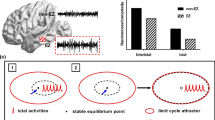Abstract
Macroscopic systems with many interacting subunits, when driven far from equilibrium, exhibit self-organization, for example when a pathological rhythm appears suddenly in an epileptic patient. Sudden changes occurring while conditions vary smoothly have, in cases of interest, underlying mathematics that are the subject of Thom’s catastrophe theory. The assumption made herein that the system’s state variables, akin to order parameters, reduce in practice to only one single real variable, ensures that the system derives from a potential function, and warrants recourse to the catastrophe theory. The order parameter is, furthermore, interpreted as a measure of the electropathophysiological activity in the brain, increasing monotonously with the degree of neuronal synchronism. With two neuronal influences, excitatory and inhibitory, as control parameters, the catastrophe is the archetypal cusp. Implementation of catastrophe theory leads to equations showing that fluctuations in a system’s dynamics may be utilised for signalling steps precursory to oncoming catastrophes. Pre-seizure dynamics in epileptic patients exhibit steps towards and away from catastrophe; the steps away are interpreted in terms of homeostatic feedback, consequent on changing patterns of neuronal activity. A number of characteristics of epileptic seizures of differing types merely follow from the geometry of the cusp equilibrium surface. In particular, types of seizures are distinguished by their angle of final approach to onset in parameter space. The measurable parameters by which approach to catastrophe is characterized, may be of use in investigations of the organism’s plasticity in epileptic patients, and in tests of therapeutic means for preventing seizures. There is no need to resort to a model, in the usual sense of the word, and therefore no differential equation needs to be set up.
Similar content being viewed by others
References
Cerf R, El Ouasdad H (2000) Spectral analysis of stereo-electroencephalograms: Pre-ictal slowing in partial epilepsies. Biol Cybern 83:399–405
Cerf R, El Ouasdad H, Kahane P (2004) Criticality and synchrony of fluctuations in rhythmical brain activity: Pre-transitional effects in epileptic patients. Biol Cybern 90: 239–255
Durand G. (2002) Le “Pre-ictal Slowing” dans les sciences de la culture. Loxias N° 2–3:27–35 University of Nice, France
Eigen M (1971) The hypercycle. A principle of natural self-organization. Naturwissenschaften 64:541–565
Engel J (1995) Inhibitory mechanisms of epileptic seizure generation. Adv Neurol 67:157–171
Engel J (1996) Excitation and inhibition in epilepsy. Can J Neurol Sci 23:167–174
Grassgerger P, Procaccia I (1983) Characterization of strange attractors. Physica D 9:189–208
Haken H (1977) Synergetics. Springer, Berlin, Heidelberg, New York
Hänggi P, Talkner P, Borkovec M (1990) Reaction-rate theory: fifty years after Kramers. Rev Mod Phys 62:251–341
Harris KD, Csicsvari J, Hirase H, Dragoi G Buzsaki G (2003) Organization of cell assemblies in the hippocampus. Nature 424:552–556
Jirsa VK, Friedrich R, Haken H, Kelso JAS (1994) A theoretical model of phase transitions in the human brain. Biol Cybern 71:27–35
Kramers HA (1940) Brownian motion in a field of force and the diffusion model of a chemical reaction. Physica 7:284–304
Landau LD, Lifshitz EM (1958) Statistical physics. Pergamon, London
Lerner DE (1996) Monitoring changing dynamics with correlation integrals: case study of an epileptic seizure. Physica D 97:563–576
Litt B, Echauz J (2002) Prediction of epileptic seizures. Lancet Neurol 1:22–30
Mormann F, Kreuz T, Andrzejak RG, David P, Lehnertz K, Elger CE (2003) Epileptic seizures are preceded by decrease in synchronization. Epilepsy Res 53:173–185
Nicolis G, Prigogine I (1977) Self-organization in non-equilibrium systems. Wiley, New York
Packard NH, Crutchfield JP, Farmer JD, Shaw RS (1980) Geometry from a time series. Phys Rev Lett 45:712–716
Poston T, Stewart I (1978) Catastrophe theory and its applications. Dover Mineola, New York
Sachs L (1984) Applied Statistics. Springer, Berlin, Heidelberg, New York
Saunders PT (1980) An introduction to catastrophe theory. Cambridge university press, Cambridge.
Schöner G, Haken H, Kelso JAS (1986) A stochastic theory of phase transitions in human hand movement. Biol Cybern 53:247–257
Takens F (1980) Detecting strange attractors in turbulence. Lect Notes Math 898:366–381
Thom R (1972) Stabilité structurelle et morphogénèse. Benjamin, Reading, Mass
Uhlenbeck GE, Ornstein LS (1930) On the theory of the Brownian motion. Phys Rev 36:823–841
Whitney H (1936) Differentiable manifolds. Ann Math 37:645–680
Zeeman EC (1977) Catastrophe theory. Addison-Wesley, Reading, Mass
Author information
Authors and Affiliations
Corresponding author
Rights and permissions
About this article
Cite this article
Cerf, R. Catastrophe Theory Enables Moves to be Detected Towards and Away from Self-Organization: The Example of Epileptic Seizure Onset. Biol Cybern 94, 459–468 (2006). https://doi.org/10.1007/s00422-006-0060-1
Received:
Accepted:
Published:
Issue Date:
DOI: https://doi.org/10.1007/s00422-006-0060-1




